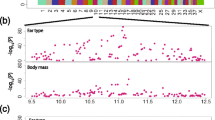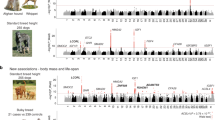Abstract
Domestic animals have a sufficiently old history (thousands of generations) to allow evolution of phenotypes, but also a sufficiently young history (~10,000 years) to allow powerful genetic dissection of phenotypic diversity. Domestic animals are therefore a unique resource for exploring genotype–phenotype relationships. Quantitative Trait Locus (QTL) mapping has been very successful in domestic animals but the identification of Quantitative Trait Mutations (QTMs) has been hard although a few prominent success histories have been reported. Genome-wide association analysis is now emerging as a powerful method for high-resolution mapping of loci controlling phenotypic traits in domestic animals. In two recent proof-of-principle studies we have used this approach to identify the mutations underlying two monogenic trait loci in dogs, white spotting and the hair ridge in Ridgeback dogs. In each case, we used only about 10 cases and 10 controls and mapped the locus to a region of about one mega base pair. In both cases the underlying mutations were non-coding underscoring the significance of regulatory mutations as a source for phenotypic diversity. Furthermore, we were able to shed light on the evolution of the allelic series at the white spotting (S) locus in dogs which encodes the microphthalmia-associated transcription factor (MITF). Our data showed that the three variant alleles described at this locus (Irish spotting, piebald and extreme white) do not represent three independent mutations but rather different combinations of a set of regulatory mutations affecting MITF expression. This is an excellent illustration of how the characterization of alleles selected during animal domestication contributes to an improved understanding of genotype–phenotype relationships.

Similar content being viewed by others
References
Andersson L, Georges M (2004) Domestic animal genomics: deciphering the genetics of complex traits. Nat Rev Genet 5:202–212. doi:10.1038/nrg1294
Barnes BR, Marklund S, Steiler TL et al (2004) The AMPK-gamma3 isoform has a key role for carbohydrate and lipid metabolism in glycolytic skeletal muscle. J Biol Chem 279:38441–38447. doi:10.1074/jbc.M405533200
Ciobanu D, Bastiaansen J, Malek M et al (2001) Evidence for new alleles in the protein kinase adenosine monophosphate-activated γ3-subunit gene associated with low glycogen content in pig skeletal muscle and improved meat quality. Genetics 159:1151–1162
Clop A, Marcq F, Takeda H et al (2006) A mutation creating a potential illegitimate microRNA target site in the myostatin gene affects muscularity in sheep. Nat Genet 38:813–818. doi:10.1038/ng1810
Fujii J, Otsu K, Zorzato F et al (1991) Identification of a mutation in the porcine ryanodine receptor that is associated with malignant hyperthermia. Science 253:448–451. doi:10.1126/science.1862346
Giuffra E, Törnsten A, Marklund S et al (2002) A large duplication associated with Dominant White color in pigs originated by homologous recombination between LINE elements flanking KIT. Mamm Genome 13:569–577. doi:10.1007/s00335-002-2184-5
Grisart B, Coppieters W, Farnir F et al (2002) Positional candidate cloning of a QTL in dairy cattle: identification of a missense mutation in the bovine DGAT1 gene with major effect on milk yield and composition. Genome Res 12:222–231. doi:10.1101/gr.224202
Grisart B, Farnir F, Karim L et al (2004) Genetic and functional demonstration of the causality of the DGAT1 K232A mutation in the determinism of the BTA14 QTL affecting milk yield and composition. Proc Natl Acad Sci USA 101:2398–2403. doi:10.1073/pnas.0308518100
Johansson M, Ellegren H, Marklund L et al (1992) The gene for dominant white color in the pig is closely linked to ALB and PDGFRA on chromosome 8. Genomics 14:965–969. doi:10.1016/S0888-7543(05)80118-1
Johansson Moller M, Chaudhary R, Hellmen E et al (1996) Pigs with the dominant white coat color phenotype carry a duplication of the KIT gene encoding the mast/stem cell growth factor receptor. Mamm Genome 7:822–830. doi:10.1007/s003359900244
Karlsson EK, Baranowska I, Wade CM et al (2007) Efficient mapping of Mendelian traits in dogs through genome-wide association analysis. Nat Genet 39:1321–1328. doi:10.1038/ng.2007.10
Kerje S, Sharma P, Gunnarsson U et al (2004) The Dominant white, Dun and Smoky color variants in chicken are associated with insertion/deletion polymorphisms in the PMEL17 gene. Genetics 168:1507–1518. doi:10.1534/genetics.104.027995
Kijas JMH, Wales R, Törnsten A et al (1998) Melanocortin receptor 1 (MC1R) mutations and coat color in pigs. Genetics 150:1177–1185
Kijas JMH, Moller M, Plastow G et al (2001) A frameshift mutation in MC1R and a high frequency of somatic reversions cause black spotting in pigs. Genetics 158:779–785
King MC, Wilson AC (1975) Evolution at two levels in humans and chimpanzees. Science 188:107–116. doi:10.1126/science.1090005
Lindblad-Toh K, Wade CM, Mikkelsen TS et al (2005) Genome sequence, comparative analysis and haplotype structure of the domestic dog. Nature 438:803–819. doi:10.1038/nature04338
Little CC (1957) The inheritance of coat colour in the dogs. Cornell University Press, Ithaca
Mackay TFC (2001) Quantitative trait loci in Drosophila. Nat Rev Genet 2:11–21. doi:10.1038/35047544
Marklund S, Kijas J, Rodriguez-Martinez H et al (1998) Molecular basis for the dominant white phenotype in the domestic pig. Genome Res 8:826–833
Milan D, Jeon JT, Looft C et al (2000) A mutation in PRKAG3 associated with excess glycogen content in pig skeletal muscle. Science 288:1248–1251. doi:10.1126/science.288.5469.1248
Olson MV (1999) When less is more: gene loss as an engine of evolutionary change. Am J Hum Genet 64:18–23. doi:10.1086/302219
Pielberg G, Olsson C, Syvänen A-C et al (2002) Unexpectedly high allelic diversity at the KIT locus causing dominant white color in the domestic pig. Genetics 160:305–311
Salmon Hillbertz NHC, Isaksson M, Karlsson EK et al (2007) A duplication of FGF3, FGF4, FGF9 and ORAOV1 causes the hair ridge and predisposes to dermoid sinus in Ridgeback dogs. Nat Genet 38:1318–1320. doi:10.1038/ng.2007.4
Steingrimsson E, Copeland NG, Jenkins NA (2004) Melanocytes and the microphthalmia transcription factor network. Annu Rev Genet 38:365–411. doi:10.1146/annurev.genet.38.072902.092717
Theos A, Truschel S, Raposo G et al (2005) The Silver locus product Pmel17/gp100/Silv/ME20: controversial in name and in function. Pigment Cell Res 18:322–336. doi:10.1111/j.1600-0749.2005.00269.x
Van Laere AS, Nguyen M, Braunschweig M et al (2003) Positional identification of a regulatory mutation in IGF2 causing a major QTL effect on muscle growth in the pig. Nature 425:832–836. doi:10.1038/nature02064
Winter A, Kramer W, Werner FA et al (2002) Association of a lysine-232/alanine polymorphism in a bovine gene encoding acyl-CoA:diacylglycerol acyltransferase (DGAT1) with variation at a quantitative trait locus for milk fat content. Proc Natl Acad Sci USA 99:9300–9305. doi:10.1073/pnas.142293799
Acknowledgements
I am grateful to Nicolette Salmon Hillbertz for help with preparing the figures. My research is funded by Swedish Foundation for Strategic Research, The Swedish Research Council for Environment, Agricultural Sciences and Spatial Planning and The Swedish Cancer Society.
Author information
Authors and Affiliations
Corresponding author
Rights and permissions
About this article
Cite this article
Andersson, L. Genome-wide association analysis in domestic animals: a powerful approach for genetic dissection of trait loci. Genetica 136, 341–349 (2009). https://doi.org/10.1007/s10709-008-9312-4
Received:
Accepted:
Published:
Issue Date:
DOI: https://doi.org/10.1007/s10709-008-9312-4




